By Mary Grlic
Cables and wires are the highway for your data and communication. A good wiring system allows for a high speed internet connection, organization, and optimal internet safety. With a well-designed and well-managed networking system, you can be sure that your organization will receive great connection and communication. But what goes into wiring and cabling your network? Here is your guide to Ethernet network cables and wiring.
Your Mini-Guide to Network Wiring
Let’s Start with the Basics
We’re going to divide this mini-guide into two sections. First we’ll look into cables, leaning about Ethernet, and understanding the differences between ethernet categories. After that, we’ll look into other parts of your network: additional cables, wall jacks, and patch panels.
What is Ethernet?
Ethernet allows for hard wired internet connections. Some advantages of ethernet include a private, high-speed network, reliable communication, and minimal interference. Because devices connect directly to the internet via ethernet cables, ethernet connection is much safer than wireless internet (Wi-Fi). However, it’s not very portable, which is why you don’t typically see wired networks in public places. Your business will definitely benefit from ethernet wiring for maximum security and high-speed internet access.
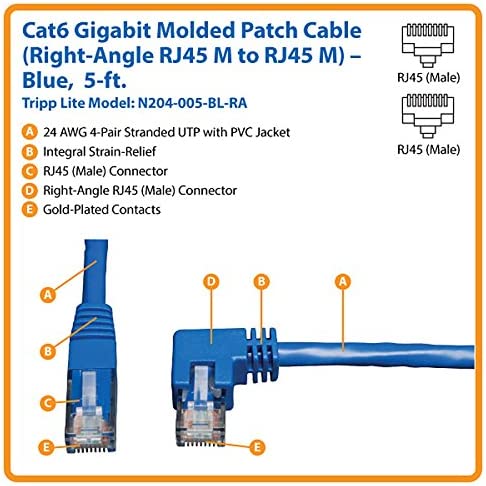
Ethernet Cables
Ethernet is a communication technology that connects devices in a local area network (LAN). Unlike WiFi, which is a wireless connection, Ethernet uses cables to transmit data. Ethernet cables were first introduced nearly 50 years ago and can be categorized based on each new generation. The rule of thumb is that newer cables, like Cat6 and Cat7, have faster data transmission speeds. In technical terms, Ethernet is also called RJ45. When you connect something via Ethernet, you would use an RJ45 to RJ45 cable, which has the proper ports on both sides.
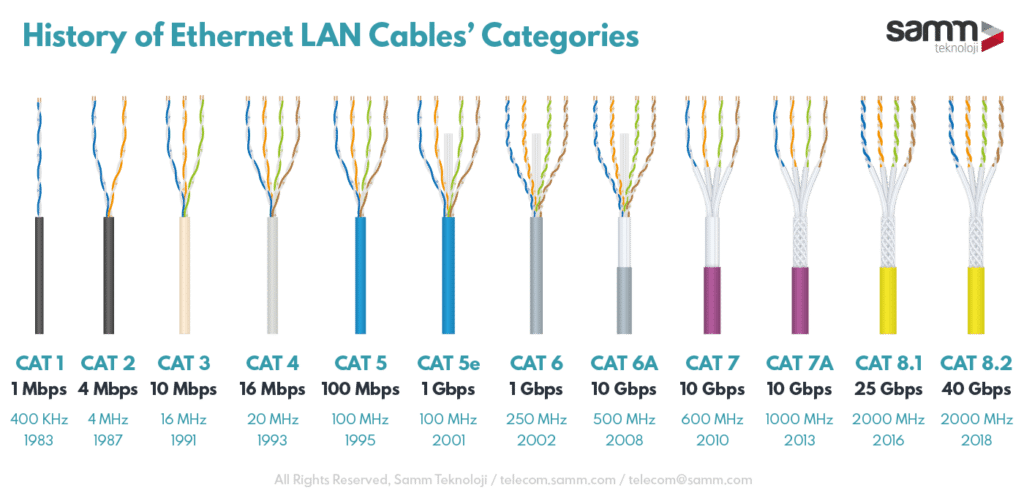
Cable Categories
Ethernet cables are divided into “categories.” The standard differences between each type of network cable includes bandwidth, distance, frequency, cost, and transmission speed.
Older Categories
Cat 1 was the first type of Ethernet cable and was the standard, common form of wiring for a long time. Following this wire, Cat2, 3, and 4 each came out with some updates.
Cat 5
First introduced in 1995, Cat 5 wires have a data rate of up to 100 Mbps. Similarly, Cat 5e is a Cat 5 cable with speeds up to 1 Gbps (1000 MGbps). These two cables look physically similar and both of them share a frequency of 100 Mhz. Cat5 is best for Internet plans with speeds lower than 100Mbps, and Cat5e is great for an affordable upgrade for standard Internet plans.
Cat 6
Cat 6 cables have a greater bandwidth and the data transfer rates reach up to 1 Gbps over 100 m like Cat 5e. The frequency of Cat 6 wires is 250 MHz. Unlike other wires, Cat 6 cables are more tightly wound and have a shielding to protect the twisted wires inside the cable. They are available in shielded and unshielded forms. Cat 6 cables help to prevent crosstalk or noise interference and are great for those looking to increase network stability. Since Cat 6a is newer, it is optimal for users who do not want outdated cables in the near future.
Newer Wires: Cat 7 and Cat 8
Cat 7 wires are even newer than Cat 6, with a speed of 10 Gpbs and a frequency of 600 Mhz. Another subcategory of Cat 7, Cat 7a, has a frequency of 1000 Gpbs. Cat 8 wires have an even greater speed and frequency at 25 Gbps (for 8.1) or 40 Gbps (for 8.2) and 2000 MHz respectively. However, since Cat 8 wires are newer, they are also more expensive, so they are a good investment for those who are interested in newer technologies. Similarly, Cat 7 wires are quite new but better for people looking for data transfers.
UTP vs. STP Cables
Cables may come in unshielded (UTP) and shielded (STP) forms. They use a special type of copper telephone wiring for business installations. Shielded twisted pair cables are great for cable set ups that may otherwise have potential interference. UTP, on the other hand, is a popular type of cable in the world of telecommunications and computer industries for Ethernet and telephone wires. Conductors form a simple circuit and are twisted around one another to cancel out electromagnetic interference. UTP is common in LAN (local area network) environments because they are unshielded.
More Wiring: Copper vs. Fiber Cabling
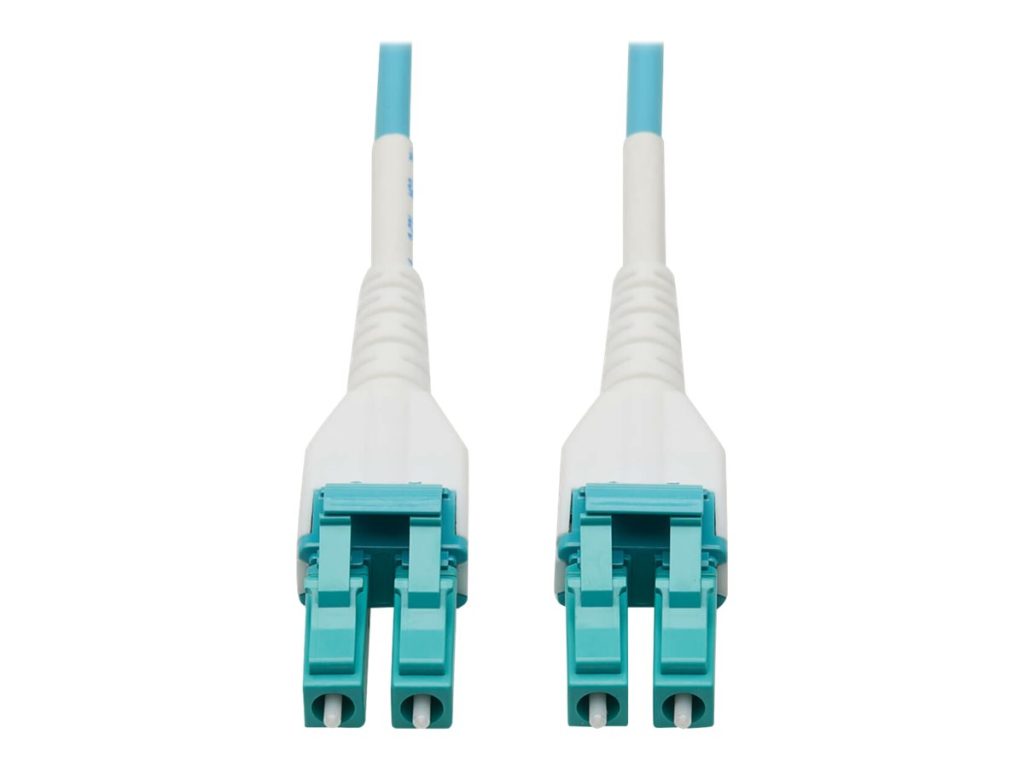
Technically speaking, copper wires carry electrical pulses along metal strands. On the other hand, fiber wires carry pulses of light on flexible glass threads. Copper uses electrons for data transmission while fiber uses photons. Since light travels faster than electricity, fiber wires are quicker than copper. Fiber optic cabling is becoming the network cable of today because of its reliability, increased bandwidth, and transmission capabilities (speed and distance). They are also more weather resistant because of the multiple layers, making them ideal for communications across long distances. These cables are so resistant that the global internet is connected via submarine cables, fiber cables laid on the ocean floor. You have probably heard the term “fiber optic” with Cablevision or other internet service providers.
Organizing your Network Cables
Reduce the headache and make sure your business always has access to high-speed, reliable internet by organizing your wires. Managed service providers, like Computero, can help you fix your wiring mess with professionally installed wiring. There are a few parts of network cable installation that’ll help keep your network organized and easy to manage. Let’s take a look at some of the ways we can help organize your wiring system.
What is a Patch Panel?
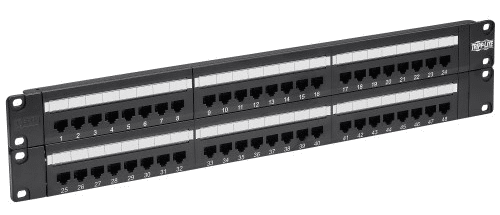
Your typical IT closet will have a patch panel which connects various IT devices together. These panels allow for connection within an office room or floor, connecting the LAN (local area network) to WAN (wireless area network). Patch panels, installed by professional IT firms, can help to keep your wires organized. Otherwise, you may have a “wiring mess” which can greatly complicate things. A patch panel simply looks like an array of (Ethernet) ports on a single panel with a bunch of wires that connect to these ports via a patch cable. An IT specialist configures a patch panel to connect with multiple devices or cables.
What is a Wall Jack for Ethernet?
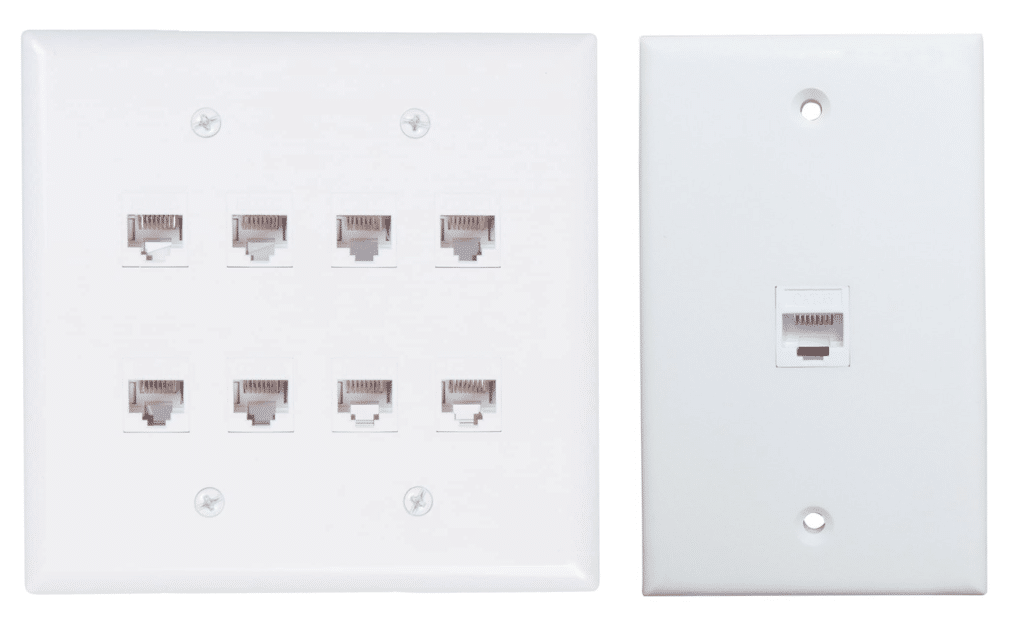
Your network cables will be able to connect to the wall with an Ethernet wall jack. This is another aspect of construction that should be taken into consideration when installing your network. It is simply a port that enables you to connect to the internet via hardwired connections. Your managed IT service provider will connect any devices or systems through this wall jack, which will have concealed network wiring behind it. It’s just like your electrical wiring. Think about plugging in your computer to the wall with a power cord to turn on your device. Now, you would use an ethernet cable to connect your device to the internet.
Tripp Lite Cables

Tripp Lite is one of the companies that provide cables and connectivity for network systems. They sell all types of cables mentioned above, like Cat 6 or Cat 5e wires. You or your managed IT service provider can select the necessary cable type, length, shielding, color, and compatibility, making them a great choice for your ethernet cable connection. At Computero, we trust Tripp Lite for their reliability and durability.
How Computero Can Help
Here at Computero, we can help you with all of your network wiring and cabling needs. We have done network cabling and wiring services for many of our clients, giving them access to high speed networks and relieving the wiring headache. Professionally installed networks have so many benefits, including:
- A network layout based on your IT needs and budget
- Optimized utilization of your internet and equipment
- Faster transmission speeds
- Less interference
- Optimal communication
Additionally, Computero completes testing and quality assurance after every installation. This way, both you and our technicians can be sure that your network is ready to go. Proper network cabling and wiring is essential and Computero is here to help! Contact us today.





0 Comments